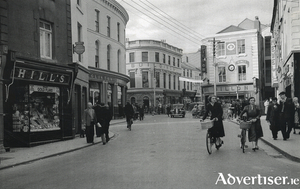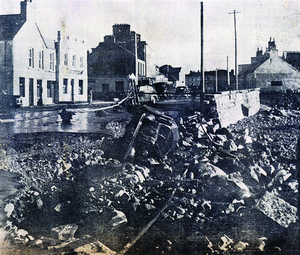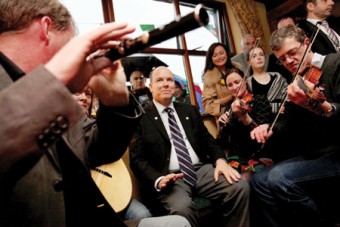Search Results for 'electricity poles'
7 results found.
Elegant streetscape

There is a lovely vintage quality about this photograph of the most elegant corner in Galway, which was taken about 1950 at almost 6.15 in the afternoon. It shows how the three corner buildings, all of which are slightly rounded, complement each other. It was always known as Moon’s Corner or Dillon’s corner, never McNamara’s corner.
Hurricane Debbie

On the morning of September 16 1961, gale warnings were issued because of a possible impending storm. Violent storms are almost never actual hurricanes by the time they reach Ireland, but all of that was about to change that morning. Hurricane Debbie was the only hurricane, that is known about, to have made landfall in Ireland as a Category 1 event. Gusts of more than 180 kilometres an hour were recorded, and while the winds were not as strong as the gusts, they were capable of causing a lot of damage. Eighteen people died in Ireland as a result of the storm, six in the North and 12 in the South. They were killed by collapsing walls and trees, one was drowned from a small boat, and a young boy was blown into a stream. Tens of thousands of houses and other structures were damaged, some were completely destroyed, some suffered roof loss, while others had lesser damage such as windows blown in, etc.
No to posters on ESB electricity poles
ESB Networks is warning against the placing of posters on electricity poles/structures during the forthcoming referendum campaign.
Charles Lamb in Galway

Historic paintings of Galway are scarce enough so it is always good to come across them. Our image today is one of the Claddagh painted by Charles Lamb in the 1930s. It is hardly surprising that visitors, painters, poets, and novelists were attracted to this fishing village that was in Galway, but not of it. They were all fascinated by the odd assortment of thatched cottages, built at haphazard angles, with intersecting streets and lanes in which one could lose one’s way within a couple of acres. Sometimes they were built in irregular squares or circles around little greens where the young children played. The houses were very small, and while some showed signs of poverty, most were very clean and neat. The back doors of many of the houses looked into the front door of their neighbours, and though the buildings were quaint, picturesque, and romantic, modern sanitation was unknown there.
Charles Lamb in Galway

Historic paintings of Galway are scarce enough so it is always good to come across them. Our image today is one of the Claddagh painted by Charles Lamb in the 1930s. It is hardly surprising that visitors, painters, poets, and novelists were attracted to this fishing village that was in Galway, but not of it. They were all fascinated by the odd assortment of thatched cottages, built at haphazard angles, with intersecting streets and lanes in which one could lose one’s way within a couple of acres. Sometimes they were built in irregular squares or circles around little greens where the young children played. The houses were very small, and while some showed signs of poverty, most were very clean and neat. The back doors of many of the houses looked into the front door of their neighbours, and though the buildings were quaint, picturesque, and romantic, modern sanitation was unknown there.
History repeating itself in royal visit to Newport for a number of reasons

Not for the first time the small village of Newport became a hive of activity because of a visit from the royal family of Monaco. On Wednesday, following in the footsteps of his late mother and father, Prince Albert of Monaco visited the ancestral home of his late mother, Princess Grace, in the west of the county.
McDonnell calls for poles to be removed on Ballybaanmore Road
The Galway City Council and the ESB must work together to remove the electricity poles on the Ballybaanmore Road so that road works in the area can be completed.

